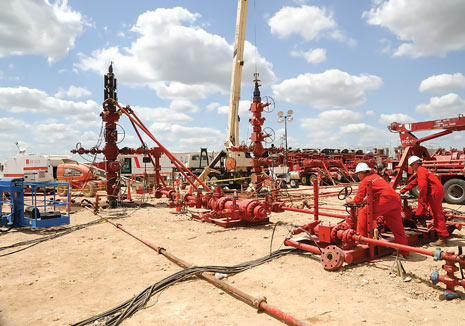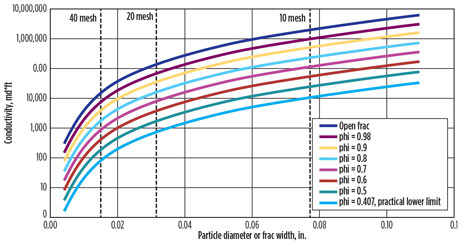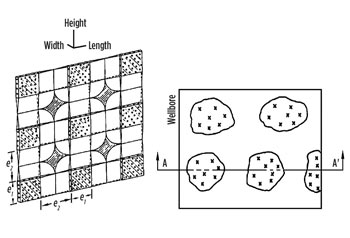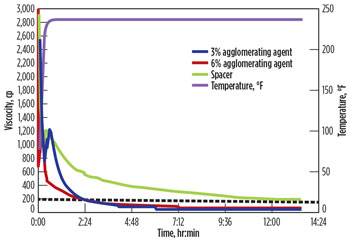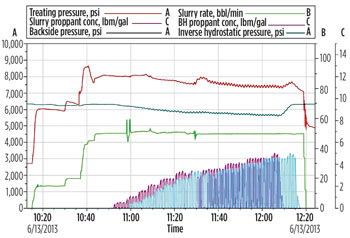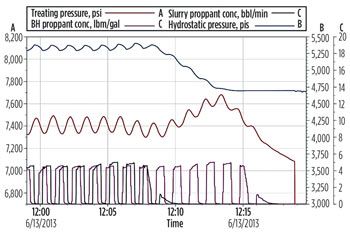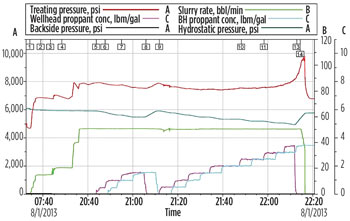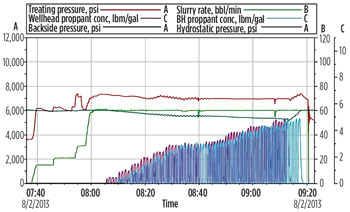Development and field application of highly conductive, proppant-free channel fracturing
Injection pressures of proppant-laden slurry and proppant-free spacer, using a pulsing approach, were found to be significantly lower than those applied with conventional hydraulic fracturing treatments.
Extensive laboratory experiments and large-scale testing were performed to evaluate the formation and stability of proppant aggregates and proppant-free channels (PFCs). Proppant-laden slurry (prepared by mixing fracturing sand coated with an agglomerating agent in a gel fluid) and cross-linkable, proppant-free spacer fluid were pulsed intermittently to form proppant-aggregated masses surrounded by proppant-free gel slugs. Highly conductive channels were formed, surrounding the proppant aggregates, after cross-linked gel slugs were broken and removed from the propped fracture, leaving behind proppant-aggregated masses that supported the closed fracture. Field trials were performed in both unconventional and conventional oil formations. Injection pressures of proppant-laden slurry and proppant-free spacer, using the pulsing approach, were found to be significantly lower than those applied with conventional hydraulic fracturing treatments, indicating this new method helps alleviate the risks of screen-out, as the proppant-free spacer sweeps and mitigates the proppant buildup in the near-wellbore (NWB) area. Field results showed production in wells treated with the proppant-free channel fracturing method increased significantly, even using 40% less total proppant, compared to production of offset wells in which conventional fracturing treatments were performed. BACKGROUNDFrom its earliest applications more than five decades ago, hydraulic fracturing of formations has provided dramatic improvements in hydrocarbon production rates. However, the production rate often declines over several months back to or below the pre-stimulated output rate. This rapid decline in the stimulation effect led to studies of gelled fluids, breakers, and propping agents that continue to this day. It is generally accepted that propping agents maintain fracture width and provide fracture conductivity to the well. These agents should be strong enough to withstand the environmental stresses placed on them during the well’s production life. If these materials crush, it follows that the conductivity of the proppant-packed fracture will be diminished, reducing conductivity and well production. The importance of fracture conductivity, and its effects on well productivity, is well-understood in the petroleum industry (Soliman and Hunt 1985). Laboratory testing procedures are well-documented, and databases are available to the industry to help design engineers optimize the fracture treatment designs in terms of fracture geometry, proppant concentration, proppant type, and fracturing carrier fluid. Despite the availability of advanced design tools and large amounts of conductivity test data, post-treatment performance in many wells seems to suggest that the effective fracture length might be shorter than expected. The shorter, effective fracture lengths might be the result of fluid cleanup issues or loss of fracture conductivity resulting from fluid residue, such as filter cake or formation embedment of proppant. Effective fracture length can be affected by broken fluid properties and the conductivity in the fracture (Schubarth et al. 1998; Neghaban et al. 1998). CREATING PROPPANT-FREE CHANNELSThe current state-of-the-art fracturing practice is to fill the fracture with a multi-layer pack of rounded or spherical particles, and increase the propped width to increase conductivity. However, there are both cost and physical limitations on the amount of proppant that can be placed in a specific fracture. Therefore, there is a limit to the conductivity that can be achieved initially with conventional methods. David and Huitt (1960) showed that the conductivity of an open fracture can be much greater that flow through a proppant-fraced fracture. In Fig. 1, the top curve illustrates a fracture that is completely open without particles supporting the fracture walls. The bottom curve represents a fracture that is filled completely with round, uniform-sized, spherical particles in a complete monolayer. This curve has the lowest porosity (41%), and has the lowest conductivity for this type of fracture, of any given width.
Over the years, various approaches have been examined to provide a practical cost-effective means for increasing the conductivity of the propped fractures. In the early 1970s, Tinsley and Williams (1973) examined the concept of placing spaced proppant beds randomly throughout the fracture, in which the proppant beds function as pillars to hold the fracture faces apart, allowing the fluid to flow between the proppant beds, Fig. 2. These spaced proppant beds are distributed over the fracture face in a pattern of irregularly shaped pillars capable of supporting the closure load. The fracture faces are not in contact with each other for some distance away from the edge of the proppant bed, because of the support given by the proppant bed. This open portion of the fracture has a much higher flow capacity than a comparable propped section.
Numerous field trials using this periodic propped bed approach were applied during the 1970s (Tinsley and Williams 1973; Fast et al. 1975; Pugh et al. 1977), but there was no reference as to why this fracturing method was discontinued and no longer applied after these field treatments. The PFCs are formed by the presence of proppant-free spacer fluid that is located around proppant-aggregate beds at the time of initial fracture closure, creating a connecting network of void areas throughout the closed fracture to communicate the producing formations adjacent to the created fractures in the wellbore. In this article, the PFC fracturing method is revisited, taking advantage of advances in new fracturing fluid systems, the application of newly developed agglomerating agents (including curable resin and tackifying agents) in treating the proppant grains to form proppant aggregates, and advancements of automated pumping equipment to effectively handle this approach for forming proppant beds or aggregates (Nguyen et al. 2007). EXPERIMENTS AND RESULTSFluid selection criteria are important for the application of PFC technology, to achieve optimal conductivity results. Fluid cleanup. The objective of PFC technology involves the generation of flow channels that will provide a near-infinite conductive system. Therefore, cleanup of the spacer fluid and proppant-aggregate-laden fluid is necessary to achieve the PFCs created by this design. Derivatized guar, or residue-free gel fluid, should be the fluid-of-choice to help ensure that the cross-linked fluid, when broken, will be clean and flow back readily, leaving no obstruction in the channels or gel residues adhering to proppant aggregates. Fluid compatibility. An agglomerating agent is used to keep the proppant aggregates together and prevent them from dispersing or breaking up as they are exposed to the high shear stress of production fluid passing through the channels between the proppant beds. Fluid compatibility testing was performed to ensure that the agglomerating agent did not interact with other chemical additives (e.g., crosslinker, breaker, etc.) included in the gel fluid and affect their functions. Carrier fluid. The carrier fluid should maintain stability during transportation of the proppant aggregates into the fracture and remain adequately stable for some time until the fracture closes, holding the proppant aggregates in place. Both instant and delayed cross-linker mechanisms for borate and metallic, cross-linked fluid systems were assessed. The metallic crosslinked fluids maintained stability at elevated temperatures, and subsequently, had better proppant suspension compared to the borate crosslinked fluids at the tested conditions. Therefore, metal cross-linked fluids were used in both the proppant-aggregate carrier and spacer fluids. To obtain the fluid design, breaker concentrations should be optimized, such that the proppant-aggregate carrier fluid breaks first, allowing proppant within the aggregates to form bonds and adhere in forming supporting proppant pods. The spacer fluid should remain cross-linked to support the proppant aggregates until the fracture closes. The proppant aggregates were coated with an agglomerating agent using a concentration of 3% and 6% volume, by weight, of proppant. Four jars were made—one for each agglomerating agent concentration (3% and 6%), a control containing no breaker, and the other with breaker. At time 0, they all had good suspension. The jars were then placed into a water bath at 200°F, and photographs were taken every half-hour to check the stability of the proppant-aggregate and spacer fluids. Figure 3 shows the rheology curves of proppant-aggregate slurries and proppant-free spacer fluid.
Proppant aggregates. When proppant is coated with an agglomerating agent, proppant grains interact with surrounding particles and form proppant aggregates at conditions of lower shear. Dewprashad et al (1999) examine the advantages of applying an agglomerating agent that includes inhibiting proppant settling, controlling fines migration, maximizing breaker efficiency, enhancing fluid recovery, and mitigating proppant movement. These unique benefits are important in the PFC fracturing treatment, because they help stabilize the aggregates and lock them in place, especially because the amount of proppant used is significantly less than for a conventional fracturing operation. Although PFCs are formed, the use of the SMA creates a tacky surface on the agglomerating-agent-coated proppant, resulting in a flexible proppant bed and immobile fines (Dewprashad et al. 1999). The coating also provides a surface that is hydrophobic, preventing water-based gels from absorbing onto the proppant grains. This is particularly useful, in that it enhances the effectiveness of the gel breakers used in the fluid (Weaver et al. 2007). In the laboratory and in large-scale testing, 3% to 6% v/w of agglomerating agent concentrations were tested and showed good adhesion between proppant grains. TESTING IN NARROW SLOTSThe treatment design concept was tested by alternating between the proppant-aggregate-laden fluid (prepared with 20/40-mesh Brady sand and an SMA aggregating agent) and the spacer fluid stages (without proppant) to form PFCs. This concept was tested and visually verified, first using a small-scale slot flow apparatus (12-in. tall, 24-in. length, ½-in. gap). The fluids were placed into two accumulators, and 100-psi pressure was applied to intermittently inject the fluids into the slot model through a 0.335-in. ID aperture. The concept of forming PFCs was again examined by pumping intermittently between clean fluid (no proppant) and slurry fluid (with proppant aggregates). This testing was performed using a large-scale slot model (11-ft length, 2-ft height, ⅜-in. gap). The gel fluid was prepared with a derivatized polymer; the proppant used was 20/40-mesh Brady sand, and the agglomerating agent was used at a concentration of 6%. The proppant-aggregate-laden fluid was injected intermittently into a flow stream of clean fluid before the commingled fluid was injected at 1 bbl/min into the slot model. Figure 4 shows the proppant-aggregate beds being transported and distributed in the slot model.
FORMING PROPPANT-AGGREGATE BEDSTable 1 provides a comparison summary of different methods that can be applied for forming proppant-aggregate beds.
Tub bypass method. The fluid pulsing action is achieved by alternate injection of proppant-aggregate-laden fluid and clean fluid at prescribed time intervals. The blender’s software and hardware were modified to handle the pulsing process, which is accomplished by switching output from the tub blender to a tub bypass, to deliver proppant-aggregate-laden fluid and clean fluid, respectively. The original tub bypass bypasses the blender’s discharge pump, but the new design uses the discharge pump when on tub bypass, which makes it possible to allow faster proppant concentration fall-off while obtaining a distinct clean (spacer) stage. The blender software was modified to automatically switch between the tub and the tub bypass without the operator’s intervention. This allows for simpler, better control when sequencing between proppant-aggregate-laden and clean fluid, and also when making adjustments to chemical additives. Dual-flow (commingled) method involves the use of two blenders that serve to deliver the clean fluid and proppant-aggregate slurry separately into a commingler before the wellhead. This method has the unique advantage of allowing for the adjustment of proppant aggregates instantly, which can also be ramped up or down accordingly. A commingler “T” connection was used for this approach with the spacer fluid coming from one side and pillar fluid coming in from the other side. The shear caused by the mixing transforms the continuous proppant-aggregate-laden stream that enters the mixing tee into individual proppant clumps. Pump cycling method involves cycling between the proppant-aggregate slurry and clean fluid using the pumps. It includes two different blenders, and a rig-up similar to the dual-flow option. The only difference is the application of the equipment. The proppant aggregates are generated using the appropriate pumps, which makes it also similar to the tub bypass method, except that the pulsing is performed at the pumps. This option has the drawback of causing shut-downs when proppant locks up a pump. FIELD TRIALSEgypt. The PFC fracturing technique was applied in the Abu Roach formation of Egypt’s Western Desert. The formation comprises seven members, and is mainly limestone with interbeds of shale and limestone (Al Mahdy 2013). A unique modeling software was employed to prepare the final design parameters. The design used 35% less proppant than a conventional design, and the proppant stages were designed with 13 cycles per proppant concentration stage, with a tail-in of 8 lbm/gal of 12/18-mesh intermediate strength proppant to prevent a choke effect near the wellbore. Each pulsing stage included a proppant-aggregate-laden fluid duration of 30 sec and a clean fluid duration of 10 sec. A clean fluid was designed to be stable for the fracture closure time, as well as to be compatible with the agglomerating agent used in treating the proppant. The PFC fracturing treatment was placed, as designed, Fig. 5. The pulsing sequence was accomplished successfully with the proppant concentrations reaching the set point quickly without delay. The fluid cross-linked properly and the sand crews were able to sequence on and off while agglomerating agent was also being applied on the proppant.
Eagle Ford. The PFC fracturing method was performed in two wells of a four-well pad, and in one well of a three-well pad (all wells are horizontal and use multi-stage fracture completions). The formation properties were examined through a rigorous candidate selection process. A treatment design was determined, and an agglomerating agent was selected, along with a compatible proprietary surfactant. On the four-well pad, the two wells were completed with 5½-in. casing and 23 lbf T-95 and P-110. The wells have bottomhole static temperatures (BHSTs) of 280°F and a fracture gradient of 0.95 psi/ft. The average fluid stage volume was 298,000 gal with a proppant amount of 212,000 lbm, while the conventional design had an average of 308,000 gal and 280,000 lbm, respectively, per stage. Each pulsing sequence included a proppant-aggregate-laden fluid duration of approximately 35 sec, and a clean fluid duration of approximately 35 sec. No screenout was observed throughout the fracturing treatment. The initial production results indicated that the wells are similar or better than those using a conventional fracturing design, even though the proppant amount was reduced by almost 30%. The PFC treatments required 20 hr less for pumping and almost 1 MMlbm less of proppant for the entire well. Figure 6 shows the treatment chart of a PFC fracturing treatment stage (one stage is shown in Fig. 7).
The treatment chart in Fig. 6 shows the signature wave-like response of density variations on the pressure graph, indicating that the spacer and proppant-aggregate slurry stages are separated going down the wellbore. The fluctuations in the surface treating pressure continued during the flush, even when proppant was no longer being added and hydrostatic pressure was decreasing. The fact that the treating pressure did not rise on a steady slope indicates that the proppant-aggregate-laden fluid was entering the formation (and exiting the wellbore) in slugs, which confirms the calculated hydrostatic pressure fluctuations and verifies that the slugs are remaining intact all the way to the perforations. The PFC fracturing approach delivers a design with reduced proppant and stable proppant-aggregate beds at the desired fracturing injection rate without issues of sand screenout. Furthermore, the signature wave-like pressure response continues, even when all of the slurry enters the horizontal section of the well. This indicates that the spacer fluid and the proppant-aggregate-laden fluid are still remaining distinctly separated from one another as they enter the formation. This is shown in Fig. 7, which is an expanded view of the flush, beginning at approximately 12:08 on the surface. In the second case, a three-well pad, only one well was completed using the PFC fracturing technique. As shown below, the two wells completed with the conventional fracturing method had proppant placement difficulty and screened out, Fig. 8. However, the PFC-fractured well showed lower treating pressure, even with higher proppant concentrations, Fig. 9.
CONCLUSIONSBased on the results obtained from the evaluation testing and field trials of the revised PFC fracturing method, the following observations were made:
ACKNOWLEDGEMENT This article is adapted from SPE paper 168996 presented at the SPE Unconventional Resources Conference, The Woodlands, Texas, April 1-3, 2014. REFERENCES
|
||||||||||||||||||||||||||||||||||||||||||||
- Shale technology: Bayesian variable pressure decline-curve analysis for shale gas wells (March 2024)
- Prices and governmental policies combine to stymie Canadian upstream growth (February 2024)
- U.S. producing gas wells increase despite low prices (February 2024)
- U.S. drilling: More of the same expected (February 2024)
- U.S. oil and natural gas production hits record highs (February 2024)
- U.S. upstream muddles along, with an eye toward 2024 (September 2023)
- Applying ultra-deep LWD resistivity technology successfully in a SAGD operation (May 2019)
- Adoption of wireless intelligent completions advances (May 2019)
- Majors double down as takeaway crunch eases (April 2019)
- What’s new in well logging and formation evaluation (April 2019)
- Qualification of a 20,000-psi subsea BOP: A collaborative approach (February 2019)
- ConocoPhillips’ Greg Leveille sees rapid trajectory of technical advancement continuing (February 2019)

